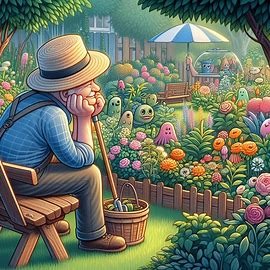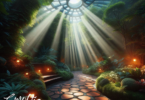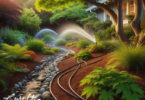Shade gardens are peaceful areas filled with plants that love low light. This guide will dive into everything you need to know about creating a garden that thrives in the shade.1 It will share tips on design, using native plants, and picking the right foliage.2 You’ll learn how to make your garden beautiful even with little sunlight.3
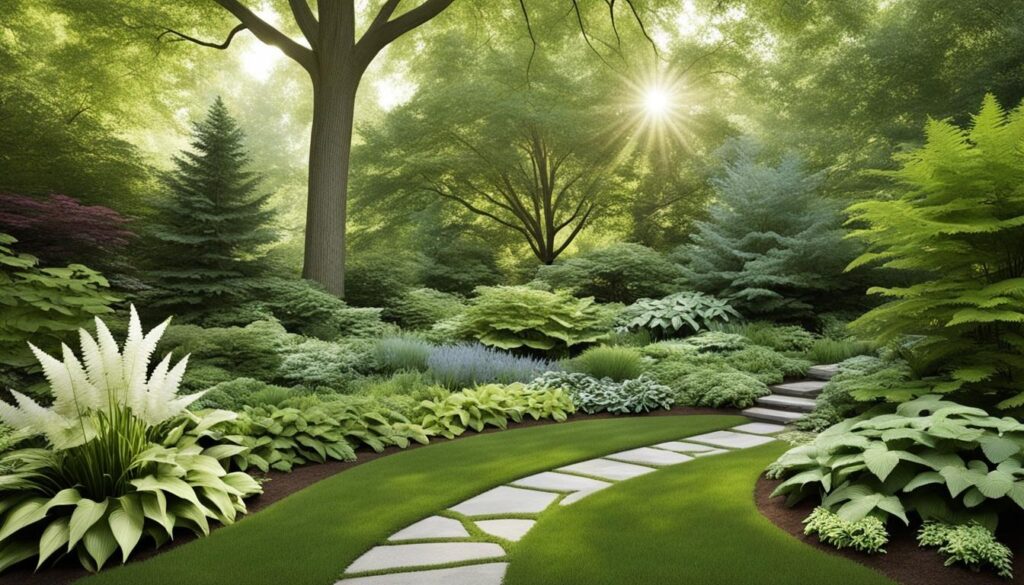
Key Takeaways
- Shade gardens offer a serene retreat with a unique opportunity to cultivate a diverse array of low-light plants.
- Understanding different shade types, from full shade to seasonal shade, is crucial for successful shade garden design.
- A wide range of vibrant foliage, shade-loving flowering perennials, and evergreen groundcovers can thrive in shaded areas.
- Incorporating native plants and embracing a naturalistic design approach can create a biodiverse, wildlife-friendly shade garden.
- Thoughtful soil preparation, watering strategies, and pest management are essential for maintaining a healthy and thriving shade garden.
Introduction: Why Shade Gardens Matter
Shade gardens are vital for creating calm and lovely outdoor spaces. They face a challenge – fewer plants can grow where the sun is low4. Yet, they give gardeners a chance to highlight many plants that love shade. With this, we will explore the wonder of shade gardening. We want to show you the beauty and the good things about making these dark, peaceful spots.
Challenges and Opportunities of Shaded Areas
Shade gardening has its own difficulties. Less light means some plants won’t grow well4. But, it’s also a chance to find and use plants that love shade. They turn dark spots into beautiful, inviting places. For example, the sweet box plant needs just a little sun each day4. Other plants like those that deer won’t eat and those that bloom in winter also fit well4. So, the list of plants for shade gardens is exciting and endless.
Embracing Nature’s Serene Oasis
Choosing shade lets gardeners make peaceful nature spots. They soothe the mind and offer a quiet break. Shade gardens let you pick a wide variety of plants. You can go for small bushy plants like Sarcococca hookeriana var. humilis4. Or, big, leafy plants that love the damp and have lots of natural matter4. These spaces draw you closer to nature. They help you feel calm and refreshed.
Understanding Shade Types
To start a successful shade garden, you need to know about the different types of shade. It’s important to understand how each one affects plants. We will look at full shade, partial shade, and seasonal shade in this section.
Full Shade: The Deep, Dappled Canopy
Full shade is found where there’s little to no direct sunlight, like under thick tree canopies or shadows of buildings.5 Here, plants might see less than an hour of direct sun daily.5 In full shade, plants have leaves that are often broad and thin. Some plants even change their leaves to capture more sun.5 Evergreens do well in these conditions. They can catch sunlight, given the temperature stays above 45°F.5
Partial Shade: Dappled Sunlight Havens
Partial shade gets 3-6 hours of direct sun daily.6 It creates a patchy light pattern. This amount of sun makes it perfect for many different plants.6 Dappled shade is often found under deciduous trees. It offers a mix of shade in summer and more sun in cooler months. This cycle is great for plants like anemones and primulas.7
Seasonal Shade: Everchanging Light Patterns
In seasonal shade, light changes throughout the year. As deciduous trees drop their leaves, more sun reaches the ground. This allows for sun-loving plants to bloom in spring.7 Then, the shade grows again for summer plants.7 Gardens that face north see a lot of shade, but they get good sun in the evening during warmer months. This is perfect for plants like hellebores and snowdrops.7 West-facing gardens get morning shade but bright afternoon and evening sun. They are great for plants that can handle summer heat, such as camellias.7
shade gardens: A Palette of Possibilities
In shade gardens, you might think there are fewer plant options than in the sun. But, there’s still a wide variety of amazing plants that love low-light conditions. Here, you’ll see the best picks for shade gardens. We’ll talk about plants with bright foliage colors and textures, shade-loving flowering perennials, and evergreen shrubs and groundcovers.
Vibrant Foliage Colors and Textures
This section shows how to pick plants with eye-catching leaf colors. You’ll find everything from deep greens to plants with unique patterns.8 For example, a garden has over 250 Japanese maple trees, known for their varied colored leaves.8 You’ll also learn which plant types, like Acer palmatum and Hakonechloa macra, do best in low-light foliage. Knowing these details is key to success in shade gardens.8
Shade-Loving Flowering Perennials
8 Keeping a garden colorful all year is important. It’s not just about Japanese maples. The author talks about adding tropical plants. These include bananas, elephant’s ears, and dahlias for their colorful blossoms.8
Evergreen Shrubs and Groundcovers
This part focuses on evergreen plants which keep the garden lively throughout the year. You’ll learn how to use them to create a beautiful shade garden.8 The author emphasizes staying open to change, especially in shade gardens where light shifts. They mention how hard it can be to find certain plants due to nursery closures.8
Creating a beautiful9 shade garden means using specific design principles. This part will look at what makes shady retreats so enchanting. We’ll talk about the importance of layering plants for depth and interest, incorporating textural contrasts for richness, and adding focal points and pathways to attract the eye and encourage exploration.10 By understanding these tips, gardeners can turn shady areas into stunning, peaceful spots.
Layering Plants for Depth and Interest
Starting a beautiful shade garden involves carefully placing plants.10 Evergreen shrubs are the foundation, offering structure all year. Around them, place taller perennials and low shrubs to fill space and add layers.10 Adding vines brings height and interest. Ground covers below complete the look.10 This layering technique creates a full and appealing space.
Incorporating Textural Contrasts
Adding various textures is key for stunning shade gardens.9 Think about different plant shapes and textures. This makes the garden look interesting.10 Mix smooth, glossy leaf plants with ones that have frilly leaves for contrast.10 Don’t forget plants with colorful leaves, like variegated hostas. They add even more texture to the garden.9 Mixing textures makes the garden a delight for the eyes.
Creating Focal Points and Pathways
Place focal points and paths wisely to make the shade garden more inviting.10 Paths that wander lead people through the garden and pique interest.10 Decorate these paths with garden art or water features to catch the eye. Include spots to sit and enjoy along the way.10 Doing this turns any small, shaded area into a charming retreat. It encourages visitors to explore and relax.
Woodland Wonders: Native Plants for Shade
Gardeners aiming for a natural, sustainable shade garden should use11 native plants. We’ll explore the beauty and benefits of native species suited for the shade.
Understory Beauties: Ferns and Wildflowers
Learn about the beauty of understory plants like ferns and wildflowers. They brighten up the lower levels of the11 shade garden. For example, the11 Northern maidenhair fern is slow-spreading and thrives in heavy shade. On the other hand, the11 Canadian wild ginger prefers moist, well-drained, and rich soil and boasts large leaves.
The11 Wild geranium is a perennial that blooms from May to June and likes moist to slightly dry soil. As for11 Jacob’s ladder, it has flowers in white, blue, or violet-purple from April to June. It draws in interesting insects like native bees and is tough against deer, rabbits, and slugs.
Towering Natives: Small Trees and Shrubs
We’ll also talk about11 native trees and shrubs that tower above the garden, providing structure and seasonal beauty. For instance, the11 Black cohosh can grow 4 to 6 feet tall and 2 to 4 feet wide. It blooms with lightly scented flowers in the summer. Then, there’s the11 Creeping sedge, which is semi-evergreen, deer-resistant, and thrives in wet, shaded areas.
Using11 native plants, gardeners can craft lush, biodiverse shade spots. These gardens help local ecosystems and wildlife flourish.
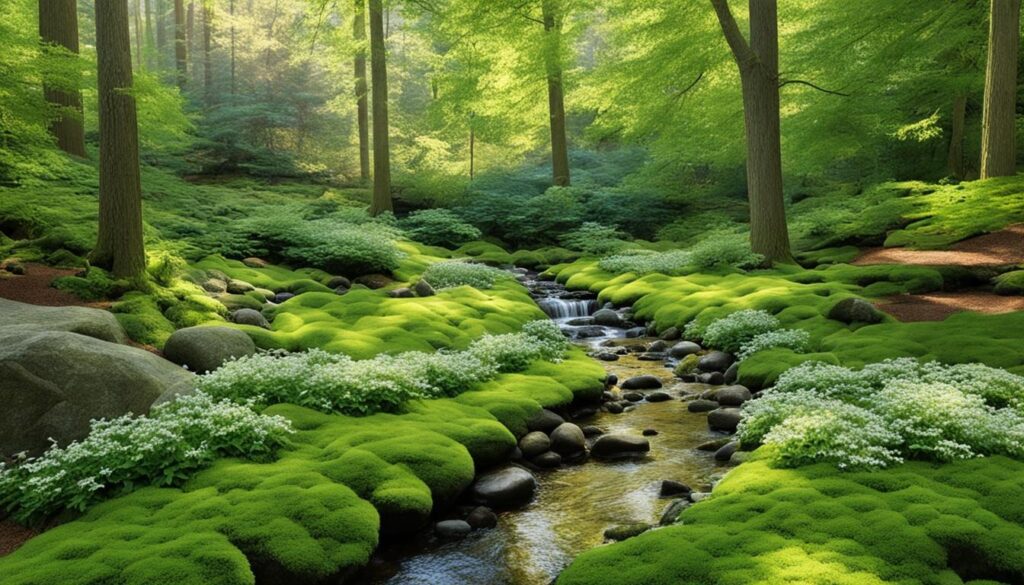
Cultivating a Shade-Friendly Oasis
Cultivating a thriving shade garden needs a full approach. It must tackle the unique challenges of growing in low light.12 This guide will take you through key steps to make a shade-friendly oasis. We’ll start with getting the soil ready and making it better.
Soil Preparation and Amendments
To grow shade-loving plants well, you need the right soil. This means adding organic matter and adjusting the pH.13 Using organic soil conditioners can improve the soil. This helps plants grow healthier in the shade.
Watering Strategies for Shaded Areas
Keeping shaded areas watered right is also important. It’s crucial for keeping plants happy, especially in drought-like conditions.13 We’ll talk about using things like landscape fabric and pine straw mulch. Smart sprinkler controllers are also great for keeping the soil moist enough for shade plants.
Pest and Disease Management
Managing pests and diseases in shade gardens is a must. It keeps your garden healthy over time.12 Watching and solving problems quickly is key to a great shade garden.
By focusing on soil, water, and keeping pests away, your shade garden can thrive. It will show off the beauty of plants that love low light.14 Adding things like hardscape elements, groundcovers, and some annuals makes these gardens even more stunning. It also helps with their upkeep.
Drought-Tolerant Foliage for Shady Spaces
Shade gardens don’t always have to be full of plants that love water. There are many drought-tolerant plants that do well in the shade15. Choosing these plants helps save water, especially in areas that don’t get direct sun15. Some good examples include Lungwort, Hellebores, and Hostas15.
New plants will need plenty of water at first. But, once they’re used to their new home, they’ll need less and can still look great15. For instance, Lungwort doesn’t attract deer, while Hellebores are tough and look good even in dry areas15. It’s also a good idea to improve the soil and check plant care before choosing them15.
Hostas are special because they can handle some sun as well as shade. Heucheras bring nice colors to gardens that don’t get much water or sun15. Other good plants for these spots are ferns and Bear’s Breeches15. These plants can cope with drier, shadier conditions and still bloom at different times, like Japanese Anemones in late summer15.
16 Hostas do well in dry, shady areas. They can end up being very big in the right conditions16. On the other hand, Lungwort is smaller but also a great fit for the shade16. Coral bells and Hellebores are also perfect for dry shade places. Just be careful, as Hellebores are toxic to pets16.
17 The data includes which plants are best for dry shade, depending on where you live. There’s a big variety to choose from, like ferns and shrubs17. Every kind of plant has info on which zones it’s good for, covering a wide range17.
17 Descriptions about the plants help gardeners pick the right ones for their shade17. The data is clear that water, sunlight, and soil matter a lot for keeping plants healthy in the shade17.
17 All in all, the data gives a full look at which plants do well in dry shade. This helps anyone working in gardens or landscapes choose wisely for shaded spots17.
Naturalistic Garden Design for Shade
Gardeners who aim to blend their shade gardens with nature often find naturalistic design best.18 They focus on embracing many plants and welcoming wildlife into the shade.
Embracing Biodiversity and Wildlife
A naturalistic approach helps gardeners make their shade gardens beautiful and ecologically balanced.18 An old lawn was turned into a cool spot for families and wildlife.18 This change brought 25 to 30 percent of non-native species that mix well with the native ones.18 These native plants don’t need extra water, food, or toxic substances, yet they help insects and birds.
Incorporating Water Features and Rocks
This guide shows how to add water features and rocks for a forest-inspired feel.19 The garden started sunny, but turned shady, requiring a different plant scheme.19 Now, unique plants fill the blooming gaps of native species.19 Recommendations for eco-friendly, shade-loving plants are included.19
Lush Greenery: Groundcovers for Shade
The key to a beautiful shade garden is dense, low-growing groundcovers. These plants can cover the ground with green, up to the taller trees. They give the garden more layers, textures, and colors.
Moss Gardens: A Verdant Carpet
For those who love shade gardens, moss is a top choice. It thrives where sun is scarce, turning the ground a soft green. This makes the garden feel peaceful and calm.20 Sweet woodruff (Galium odoratum) is a good partner for moss. It has pretty white flowers and smells nice, too. Together, they make a cool, relaxing space.20
Evergreen Groundcover Selections
Moss isn’t the only option for year-round green in a shade garden. There are many evergreen plants that do well in the dark. For example, there’s Shuttleworth’s wild ginger (Asarum shuttleworthii), Bunchberry (Cornus canadensis), and Dwarf Solomon’s seal (Polygonatum humile).20 These plants keep their leaves all the time. They fill the shaded areas with their bright greens, making the garden look and feel complete.20
Choosing the right groundcovers can turn your shade garden into a paradise. By adding these plants, you make the whole garden harmonious and beautiful, even in the shadows.
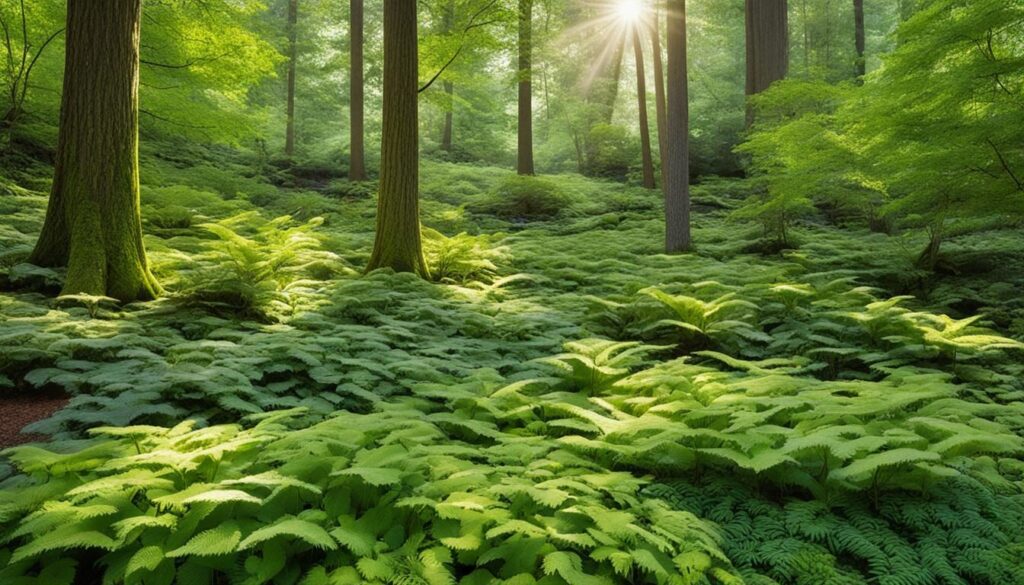
Low-Light Plant Combinations
Creating beautiful plant groupings in shade involves understanding how plants mix.14 This section helps readers design lovely, serene plant settings in shaded spots.
Harmonious Color Palettes
Developing a successful color scheme in the shade is key. Gardeners are advised to use white, gold, and red plants in low-light spaces.21 Plants like ‘Autumn Bride’ heuchera and ‘Milky Way’ epimedium, suited for Zones 5-9, work in deep shade.
For lighter shade, try bright and warm plants. Suggestions include ‘Tiger Eyes™’ sumac. These choices add flair in different hardiness zones.21
Texture and Form Interplay
Adding varied textures and forms makes plant groupings appealing.14 In 4 of 20 photos, bold textures and colors stand out in shade gardens.14 Also, 2 of 20 images highlight the importance of layering in shades.
By understanding color, texture, and structure, readers can craft captivating shade areas. These gardens will spark joy and creativity.14
Conclusion: Embracing the Serenity of Shade
Low-light gardens and shaded spots have a big charm. They help relax us, lower stress, and make us feel better. Shade is also nature’s way of protecting us from too much sun.22
Choosing the beauty of shadows can turn any outside place into a peaceful haven. There are plenty of plants and designs perfect for shady spots. This creates a tranquil, natural space.
Starting a shade garden means finding joy and renewal in a calm place. With the right plants and setting, it’s possible to make a cozy sanctuary. This haven refreshes us from our busy days.
FAQ
What are the main challenges and opportunities of growing plants in shaded areas?
Shade gardening has its challenges, like a smaller selection of plants. But, it also offers a chance to create peaceful spaces. These can be havens from the busy world around us.
What are the different types of shade and how do they affect plant growth?
There are three kinds of shade: full shade, partial shade, and seasonal shade. Full shade means little or no direct sunlight. Partial shade gets 3-6 hours of sun daily. Seasonal shade changes with the time of year.
What are some captivating low-light plants that can thrive in shade gardens?
Shade gardens have many striking plants. You’ll find colorful leaves, lovely flowers, and green shrubs. These all come together to make a beautiful, peaceful outdoor space.
What are the key design principles for creating successful shade gardens?
Designing a great shade garden involves layering plants. This creates depth and draws the eye. Adding different textures and placing focal points carefully also makes the garden inviting.
How can gardeners incorporate native plants to create a naturalistic shade garden?
To make a natural shade garden, use native plants. These include ferns and wildflowers as well as tall trees and shrubs. They bring beauty and structure to low-light areas.
What are the essential steps for cultivating a thriving shade garden?
To grow a healthy shade garden, start with good soil. Water wisely and handle pests carefully. These steps are vital for a garden that thrives in the shadows.
What are some drought-tolerant foliage options for shade gardens?
More and more plants can survive in the shade without much water. This lets gardeners create beautiful, eco-friendly gardens. They don’t need a lot of care.
How can gardeners incorporate a naturalistic design approach to their shade gardens?
For a natural look, think about biodiversity and wildlife. A garden that feels like part of the wild helps nature flourish. It’s about more than just the plants.
What are some versatile groundcover options for enhancing shade gardens?
Groundcovers like moss and evergreens fill the space under taller plants. They make the forest floor come alive, adding beauty and unity.
How can gardeners craft harmonious plant combinations for their shade gardens?
Choosing plants with care can make a shade garden stunning. Think about colors, textures, and shapes. This brings life to a garden even in the shadows.
Source Links
- https://ginghamgardens.com/shade-gardens/
- https://www.finegardening.com/article/beauty-in-the-shade
- https://www.gardeners.com/how-to/great-plants-for-shade/8201.html
- https://gardeningsimplifiedonair.com/episode-86-shade-is-hard/
- https://www.finegardening.com/project-guides/gardening-basics/distinguishing-degrees-of-light-and-shade
- https://bestall.co/from-the-garden/types-of-shade-in-a-garden/
- https://www.gardenersworld.com/plants/types-of-garden-shade/
- https://www.finegardening.com/article/how-to-design-a-colorful-shade-garden
- https://natureworksgardencenter.com/pages/shade-garden-design-basics
- https://www.fromhousetohome.com/garden/shade-garden-design-ideas/
- https://www.chicagobotanic.org/plantinfo/smartgardener/woodland_wonders
- https://barrettsadrian.com/blogs/news/creating-a-tranquil-oasis-a-guide-to-planning-your-shade-garden-with-perennial-flowers
- https://deeplysouthernhome.com/shade-garden-backyard/
- https://www.bhg.com/gardening/landscaping-projects/solving-shade/shade-garden-design-ideas/
- https://savvygardening.com/drought-tolerant-shade-plants/
- https://www.bhg.com/gardening/flowers/perennials/tough-perennials-that-grow-in-dry-shade/
- https://www.monrovia.com/be-inspired/perfect-plants-for-dry-shade.html
- https://www.finegardening.com/article/design-an-engaging-naturalistic-garden-in-the-shade
- https://www.finegardening.com/article/design-an-engaging-naturalistic-garden-in-the-shade-plant-ids
- https://www.finegardening.com/article/10-ground-covers-for-shade
- https://www.finegardening.com/article/10-combinations-for-shade
- https://fastercapital.com/content/Shade–Seeking-Solace-in-the-Shade–Embracing-Overcast-Moments.html

